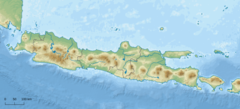| Ci Ujung Ujung river, Ciujung river | |
|---|---|
 The Ciberang and Ciujung rivers coming together at Rangkasbitung, 1910-1934 | |
| Location | |
| Country | Indonesia |
| Physical characteristics | |
| Source | Mount Halimun Salak National Park |
| • location | Bogor Regency |
| 2nd source | |
| • location | Lebak Regency |
| Mouth | |
• location | Tengkurak, Tirtayasa, Serang, Banten |
• coordinates | 5°57′47″S106°21′25″E / 5.962932°S 106.356911°E |
| Basin size | 2,159 km2 (834 sq mi) |
| Basin features | |
| River system | Ciujung basin |
The Ciujung (Ujung River, as the prefix "ci" means "river") is a river in the province of West Java and Banten on the island of Java, Indonesia. Primarily in Lebak Regency, the river basin covers an area of 2,022.14 km2.
